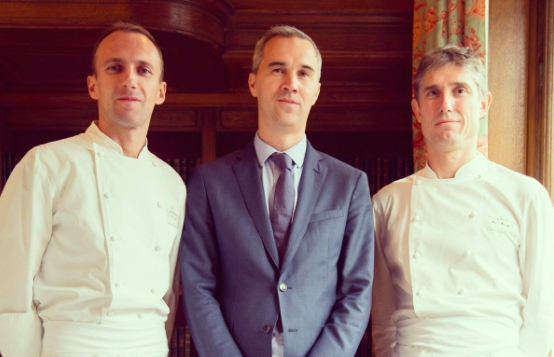If we were to say what was the most interesting opening in the Parisian restaurant scene of the past three years it would undoubtedly be Le Clarence. Opened at the end of 2015 in the elegant Hotel Dillon (the location of Bordelaise Château Haut-Brion), it has gradually strengthened its fame and is now ready to become the restaurant that more than any other can change the look of Parisian fine dining.
Chef Christophe Pelé (born in 1971 in the North-West of France) mainly trained with Bruno Cirino and Pierre Gagnaire, as well as at Pavillon Ledoyen, Lasserre, Le Bristol. In 2003 he became the first chef in the kitchen of the Royal Monceau. At the end of 2007 he took the great leap and opened a restaurant of his own, La Bigarrade, a small bistro in the suburbs (one and later two Michelin stars). In this he was helped by the sous-chef who is still working with him at Le Clarence, Giuliano Sperandio (born in Liguria in 1982).
It was just them in the kitchen, a free menu that changed daily, sometimes even during the same service. The assumption: a more or less static menu, that changes only from time to time, or seasonally, as often the case in great restaurants, kills the ingredients and is a serious handicap for the resulting compositions, no matter how supported it may be by technique and skill. Therefore, they preferred determined choices of ingredients, lots of freedom and technique, lots of improvisation, and a strong synergy. The same qualities they share today.

Italian cook Giuliano Sperandio, restaurant manager Cédric Servain and chef Christophe Pelé (photo from twitter/Haut-Brion)
however closed early in 2012 (but I did have a chance to go there three times between 2009 and 2010). At the time, in 2012, I wrote online: “When such a valuable and successful experience ends, one wonders why. For
La Bigarrade I’d say that probably such a talented chef might have found the location, and not just in physical terms, a little too small. But we will certainly hear about them again, and in search of new challenges for the pleasure of all food lovers we hope to see them soon evolve their art in another context”.
So here we are, six years later, after trying the cuisine of Pelétwice. What’s different? First, the location, now large, prestigious, comfortable, pleasing. Second, the availability of a kitchen brigade (up to 17 people in the evening) that allows the further matured creativity of the two chefs to be as free as it gets, their synergy being total, symbiotic. Third, the availability of the best products from countryside, sea, vegetables etcetera, thanks to a network of suppliers that can guarantee high quality and fresh products.
So at
Le Clarence there is no set menu, you can only choose whether to have 3, or 5, or 7 main dishes. But here comes the great news: both dining room and kitchen are flexible when it comes to the client’s desire to show a special preference or need, to be intertwined with the varied products available. The dishes that can result from the technical and composition skills of the chefs therefore make a “tailor-made” menu. A sort of fine dining
haute couture. And then there’s the interpretation of the dishes, with ingredients presented in various nuances, of exemplary beauty and successful flavours.
Indeed, when we dined there on two days in a row, we had two completely different menus, and of virtually the same high quality. Take the first menu. It included amuse-bouches, Scampi; Lobster; Sweetbreads; Duck; Cheese; Desserts. The scampi were served four times in the space of 15 minutes: Seared, tamarind, black ham from Bigorre, oregano; Raw, white peach, almond milk, begonia; Poached, umeboshi, egg yolk, almond butter; Squid (an element on the side, à la Gagnaire), capucine, basil, tuna bottarga. The sweetbreads were also served four times: Glazed, with avocado; Tomato ”green zebra”, tarama; Veal tartare, mackerel, rocket, Parmigiano; Poached, calendula, caviar, white butter. The Duck was cooked in one piece, cut by the table, with excellent pairings on the side. The dessert was light and neat.
Inspiration and creativity move freely across all the options offered by contemporaneity. The style offers a free and immediate summary of the lessons given by
Gagnaire,
Passard,
Barbot. This, however, is never as a copy. It is rather a fine craftmanship which, though without intending to be so, becomes art in the most natural way, through a spontaneous prodigious flourishing, with no emphasis. By doing so, they bring an incredible breeze of fresh air in the Parisian fine dining scene. Indeed, Paris cannot be indifferent to this example and model. The service and the wine list were also fantastic. A restaurant not to be missed.
Le Clarence dell'hotel Dillon
31 avenue Franklin Delano Roosevelt
+33.(0)1.82821010
Paris, France
Tasting menu: 90, 130 and 190 euros
Closed on Sundays and Mondays